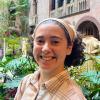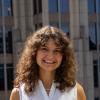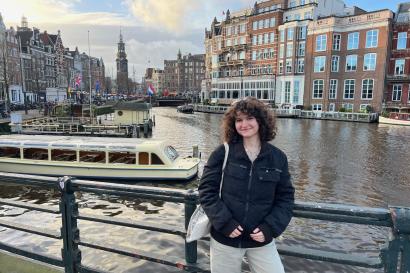After buying a ticket to Copenhagen two days before the flight’s departure on February 4th, I decided to take full advantage of the opportunity and explore not one, but two cities in not one, but two countries! I arrived into Copenhagen on that Thursday night and made my way through the metro (remarkably easy to navigate, as there are only two lines) to my hostel. As I walked out of the metro station, I was immediately greeted with the same friendly-colored buildings that I loved when visiting Amsterdam with my family years ago. I entered my hostel room to find four out of the six women sharing the room with me already asleep and decided that if they were already asleep before 10pm, they’d surely be up rather early and for the sake of my own sleep, I should get to bed early too.
Sure enough, everyone was up before 7:00 am the next morning and I took that as an opportunity to get ready and take a first walk around the city before any tourist crowds would be out and about. I stared with a walk by Nyhavn (pronounced “noo-hown”), the colorful waterside neighborhood always featured in Copenhagen tourism books and websites. While the sky in Copenhagen is grey through most of winter, the houses contrast absolutely delightfully.

Colorful waterside buildings of Nyhavn.
As I continued my walk, I found myself heading towards Christiania, a somewhat autonomous neighborhood of Copenhagen that has attempted to claim independence but is mostly just considered as a hippie-town on one edge of the city. I’m not the most adventurous person when it comes to exploring more “alternative” areas, so I decided that since I was traveling alone, the best time to visit was the morning while residents were asleep and before tourists had arrived. It was a bit of an awkward experience walking through myself (and photos are not allowed throughout the town), but there’s definitely a very counter-culture vibe there that is not at all felt in the rest of Copenhagen.

An entrance to Christiania.
Later in the day, I met up with a friend of mine from Bowdoin and we spent the rest of the day exploring other areas, such as Torvehallerne, an upscale food market housed in two identical glass buildings as well as the main shopping area of Copenhagen where you can buy lots and lots of clothing in black (as that’s apparently everyone’s favorite color in Copenhagen, even if the buildings beg to differ!).

Here I am in front of one of the many colorful streets of Copenhagen.
On the next day, I headed out to Malmö, the third largets city in Sweden, just a 45 minute train ride away from central Copenhagen. I met up with another friend of mine from Bowdoin and a few of her friends from the DIS program where she was studying in Copenhagen. Malmö is what I would call an up and coming city, as outside of the more historical looking center, it’s filled with modern housing developments. I was told that it’s become a pretty strong commuter city for Copenhagen, as Malmö has lower taxes than Copenhagen.
There aren’t many tourist sites in Malmö, but one that’s quite recognizable is the Turning Torso, a residential building designed by a Spanish architect, Santiago Calatrava. It’s 54 stories tall and the tallest building in all of the Nordic countries!

We found a massive park on the edge of the downtown area right behind the Turning Torso.
After walking near the coast with great views of the Turning Torso, we all headed back towards central Malmö and walked through neighborhoods of almost futuristic, energy-efficient-looking housing (not sure if energy-efficient-looking is really a legitimate adjective of any sort, but you’ll understand what I mean from the photo below!). It was quite quiet around and we saw almost no one walk, bike, or drive by in our whole walk back to the central train station. After we passed through the cool-looking housing, I think we entered a business neighborhood that would only be open Monday through Friday, as it was just too quiet for a weekend to be residential.

Futuristic housing in Malmö.
After we arrived back in Copenhagen, I explored a bit more before heading back to my hostel for the night. I’d only have a few more hours the next day to see more of the city and wanted to take advantage of the limited daylight!
On Sunday, I started my day with a delicious brunch with my uncle’s best friend and his family at a beautiful restaurant connected to a film center for international and artsy films. We followed brunch with a walk through the King’s Gardens, a lovely park below the Rosenborg Castle, a castle initially built as a summer home in 1606.

The King's Gardens next to the Rosenborg Castle.
I followed our walk with a trip up to the top of the Round Tower, an observatory tower that sadly wasn’t open at night while I was there, for views of the city. Buildings in Copenhagen have a limit on how tall they can be, so from any semi-tall point in the city, you can see straight across the city! I finished out my day by touring the actual Rosenborg Castle and heading back to Torvehallerne to buy snacks for my trip back to Madrid.

On top of the Round Tower on a very windy day!
Copenhagen is an expensive city, but it’s a delightful weekend trip that I’m excited to make again when my family visits in April. I’ve been meaning to make it up to Scandinavia for a number of years, so it was very exciting being able to add two countries to my list, even if I only went to one of them for a few hours!

Roya Moussapour
<p>Hi! My name is Roya Moussapour and I'm a physics major and teaching minor at Bowdoin College in Brunswick, ME. I'm super psyched to be studying engineering for the first time in Madrid. I've made it to 23 countries while traveling with my family and hope to make it to at least a few more this spring. I'm enrolled in my first Spanish class this semester since junior year of high school, so get excited to hear about my attempt at language immersion! When I'm not working on physics homework up at Bowdoin, I'm usually either in a cappella or orchestra rehearsal, so expect to hear a good bit about my experiences finding music overseas. ¡Mucho gusto!</p>





